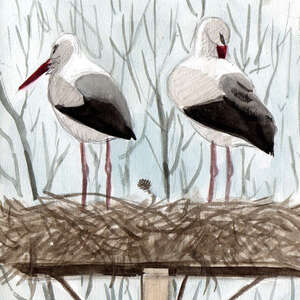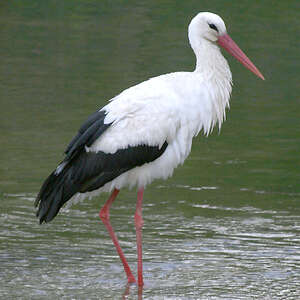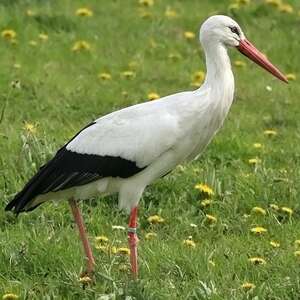White Stork
Ciconia ciconia - Cigogne blanche
Identification
The White Stork is a large wading bird with black and white plumage, with no sexual dimorphism. It is a well known bird that does not go unnoticed in its environment. The contour plumage and tail are white while the wings are bicoloured. The remiges, alula, greater coverts, and upper primary coverts are black, the rest being white. From the top view of a flying stork, one sees that the black of the wing is not homogeneous, but that the inner primary remiges and secondaries show a clear lightening along the rachis, hence a typical striated appearance of the back of the wing. In the mating season, elongated white feathers appear at the base of the neck. The strong pointed beak is crimson, as are the long legs. At the lower base of the beak, the denuded gular area is red and black. The dark eye is included in an oblong black bare skin area which gives the bird a severe look. It is very common to observe a soiling of the white plumage of the adult that becomes grayish or reddish under the action of natural factors (incubation in a wet nest for example) or artificial (frequenting public dumps or lagoon stations). The juveniles have an identical plumage to that of the adult, but the black is duller, more brown. The beak, first black, then takes on a dull orange tone at the base. The legs are pinkish.
Subspecific information 2 subspecies
- Ciconia ciconia ciconia (Europe and w Asia, Middle East and n Africa, s Africa)
- Ciconia ciconia asiatica (c Asia)
Foreign names
- Cigogne blanche,
- Cigüeña blanca,
- cegonha-branca,
- Weißstorch,
- fehér gólya,
- Ooievaar,
- Cicogna bianca,
- vit stork,
- Stork,
- bocian biely,
- čáp bílý,
- Hvid Stork,
- kattohaikara,
- Witooievaar,
- cigonya blanca,
- Hvítstorkur,
- bocian biały,
- baltais stārķis,
- bela štorklja,
- Белый аист,
- シュバシコウ,
- 白鹳,
- นกกระสาขาว,
- 白鸛,
Voice song and call
Habitat
The White Stork is a species of open areas covered with herbaceous vegetation, mostly on wet substrates, but also in dry contexts.
Behaviour character trait
The White Stork is a well-known bird to the general public (isn't it she who brings the babies?). It is a bird that is not overlooked, is easy to recognize, is not very fearful and is part of human history in many regions, for example in Alsace where the stork's beaks are part of the soundscape of many villages. Indeed, adults on the nest have the habit of greeting each other loudly by beaking. Furthermore, the stork can now be observed all year round while it used to be strictly migratory, therefore absent from us in winter. We will see why later. White Storks are gregarious birds. This is observed in all phases of their life. They often feed in groups, especially in migration stops and wintering sites, less on nesting territories. Reproduction is often colonial in the heart of the area, less on the edges where the population density is lower. Migratory movements are made in troops, often of several hundred individuals, and then take on a spectacular character, a bit like other large sailboats such as pelicans or cranes at mandatory points of passage. The storks gather in dormitories for the night, usually on trees to avoid predators, sometimes in unusual places like the peak of a high roof, the horizontal arm of a crane, or even street lights.
The White Stork is a naturally not shy bird. It does not fear man but knows how to keep its distance. It often nests in an urban environment, then building its nest on a man-made building or structure. Nowadays, the stork has gained closer proximity to man. Reasons are explained in the threats and protection section.We can rejoice, but we must also be aware that the positive evolution of the populations currently being observed can, in the long run, pose a problem in natural ecosystems, since the stork is a predator of both invertebrate and vertebrate small wildlife. The pressure of stork predation could in turn endanger the populations of some of its more fragile prey, especially among amphibians and reptiles. Once again, moderation is key. Perhaps do not facilitate the installation of the White Stork where it is not, at the risk of ultimately destabilizing the ecosystems, and all the more so since the settled storks have practically no natural predators. Everywhere and always, the stork has been able to adapt to Man and his activities. This is how it knows how to follow the plow that turns a field to easily capture prey dislodged from the ground by the plowshare, or else follow the mower which makes prey previously hidden by the grass accessible. A less savory aspect of the stork is its penchant for the remnants and food waste of Man, and this probably since antiquity, which leads it to 'rummage the bins', dumps and, nowadays, technical landfills where methanisation of fermentable materials is practised. In the winter season, it can very well feed only in these sites. But this is not without danger for it. Indeed, indigestible remains have been found in the stomachs of dead storks, such as bottle rubber bands which they thought were worms and consumed, leading to death by obstruction.Flight
The White Stork's flight is an energetic, un-graceful but effective one, allowing it to reach a significant cruising speed.
Its wings are held out and beat with a low amplitude. Its large wingspan allows it to soar. Thus, for its long distance migratory travels, the stork systematically uses ascending thermal currents, which allows it to gain altitude without much effort by gliding and to cover large distances without flapping its wings. This is how it crosses seas (Gibraltar, Bosphore) in one flap when it moves from one continent to another in its trans-continental migrations. Whenever it can, the stork also uses soaring flight for its local movements.Dietfeeding habits
The White Stork's diet is entirely animal-based. It is a strict predator whose diet is highly diversified and varies according to seasons and regions.
It easily adapts to particular conditions. In reality, the stork is an opportunist which knows how to take advantage of abundant yet changing resources. The diet includes a great variety of invertebrates (large insects such as Orthoptera or certain Coleoptera, earthworms, snails and slugs, etc.) as well as small vertebrates (small fish, amphibians, reptiles, small mammals). It knows how to profit from animal population explosions, such as migratory grasshopper invasions in Africa or boom cycles of field voles in European counties. It can occasionally be a scavenger. This inclination is systematically taken advantage of nowadays when it feeds on human food waste in biodgradable waste dumps. It can even use it to feed its young in the nest. In captivity, it is an easy bird to breed because its diet is not hard to provide. For example, it is possible to feed captive storks only with farmed fish or day-old chicks recovered after selection.Reproduction nesting
White Stork nesting is originally arboreal. They do not nest in the heart of the forest but, if necessary, in the edge, in groves, rows of trees or even on isolated trees. The nest is placed in such a way that it can access the nest in flight without being hindered by dense foliage due to its large wingspan. But for a long time now, the stork has adapted to humans and their constructions, so that nowadays most nests are either on a building (roof, chimney, church tower, ruin, etc.) or on a dominant support such as a pylon or pole. She also very easily adopts artificial areas made available to her.
The nest is a permanent nest, reoccupied and reloaded every year by the couple, so that it can reach very large dimensions and weight. This is a factor to be taken into account to avoid accidents. The White Stork is a long-lived species. Sexual maturity is reached at 4 years old but a stork can still reproduce successfully at the age of 30, or even more. The White Stork is monogamous and raises only one brood per year. The nesting is either solitary or colonial, but then the colonial character is less pronounced than in other ciconids. Under natural conditions, reproduction begins with the return of the migrating partners, from March. They meet at the nest which is their rallying point. They show their attachment through greetings punctuated by beak claps and a particular gesture which aims to strengthen the ties of the couple. Then very quickly the couplings will follow. The female lays an average of 4 white and shiny eggs at a rate of one every two days. Incubation begins with the first egg laid, at the latest the next day, and is shared, the female incubating at night and the couple alternately during the day.She incubates for 32-34 days. The chicks are born covered in white down. The parents feed them by regurgitating prey into the nest. When the chicks have acquired a certain level of autonomy, after a few days old, they feed themselves. They are fed every two hours approximately. They are able to leave the nest at the age of 2 months. Their migration starts in July and the migrating adults follow them in August and September.Geographic range
The breeding area of the White Stork covers all of temperate Europe west of the Ural Mountains and extends south to the three countries of the Maghreb and east to the Near and Middle East (Turkey, Israel, Iran). A small nucleus of population (the subspecies asiatica) is found in the south of Central Asia in the former Turkestan. The population is entirely migratory, with European birds going to spend the winter in sub-Saharan Africa and Asian birds in India. Since storks dislike migrating over the sea due to lack of thermal ascents, the migration routes are terrestrial, with the two main points of passage between continents being the strait of Gibraltar to the west and the Bosphorus to the east. Since the last quarter of the 20th century, a large fraction of the European population has become settled due to captivity and suppression of the migratory instinct. This is why White Storks can be seen in Europe during winter. This sedentarism has been encouraged by a global climate warming resulting in milder winters, as well as the existence of landfill sites where the birds find food which is artificial but suits them well enough to survive.
Threats - protection
IUCN conservation status
concern
in the Wild
threatened
evaluated
The White Stork is one of the European species that has witnessed a considerable and rapid decline in the second half of the 20th century. The causes are manifold. Significant changes suffered by natural environments and agricultural spaces (land consolidation, drainage of wetlands, artificialisation of meadows, intensive use of pesticides, etc.), climatic contingencies during migration and wintering sites, as well as predation by humans for chronic lack of animal proteins can all be blamed. A particular factor has proved to be determining: the massive use of organochlorinated pesticides which had an immediate effect on some bird populations such as raptors, storks and other predators. Some species, such as the Peregrine Falcon, almost suffered local extinction. To avoid the outright disappearance of the stork, which was headed the same way, protected reintroduction centres were set up. The young storks born in these centres were kept captive, thus preventing them from migrating as their genes would dictate. These storks which were sedentary due to force, and hence avoided mortality factors related to migration and wintering conditions in Africa, have given rise to a sedentary captive population producing juveniles meant to repopulate deserted areas. It was hoped that these young would return after their wintering in Africa and settle as breeders when mature in depopulated areas. By sheer luck, the incriminated pesticides were banned due to their destructive effects. Ever since, the population of White Stork has been on the rise. It not only re-occupied its original deserted nesting areas, but is extending its geographical range as its numbers keep increasing everywhere.Human beings often give an extra helping hand to the White Stork by providing them with artificial breeding grounds which they occupy without hesitation and dumps where they can feed cheaply without repugnance. Nevertheless, threats still exist which affect mortality and therefore limit the demographic growth. Among these threats are electrocutions, collisions with the electricity transport network, wind turbines, the ingestion of indigestible or toxic products in dumps, poaching, especially in Africa, and in Africa again, the chemical spraying for locusts control, the use of bromadiolone in the fight against rodents in Europe, etc.
Sources of information
- IOC World Bird List (v15.1), Gill, F and D Donsker (Eds). 2025-12-07.
- Storks; ibises and spoonbills, James Hancock, James Kushlan et Philip Kahl
- Grands échassiers, gallinacés, râles d'Europe, P. Géroudet
- HBW Alive,
Other sources of interest
 Specification sheet created on
20/07/2023 by Jean François
Specification sheet created on
20/07/2023 by Jean FrançoisTranslation by AI Oiseaux.net
© 1996-2025 Oiseaux.net
- Accipitriformes
- Aegotheliformes
- Anseriformes
- Apodiformes
- Apterygiformes
- Bucerotiformes
- Caprimulgiformes
- Cariamiformes
- Casuariiformes
- Charadriiformes
- Ciconiiformes
- Coliiformes
- Columbiformes
- Coraciiformes
- Cuculiformes
- Eurypygiformes
- Falconiformes
- Galliformes
- Gaviiformes
- Gruiformes
- Leptosomiformes
- Mesitornithiformes
- Musophagiformes
- Nyctibiiformes
- Opisthocomiformes
- Otidiformes
- Passeriformes
- Pelecaniformes
- Phaethontiformes
- Phoenicopteriformes
- Piciformes
- Podargiformes
- Podicipediformes
- Procellariiformes
- Psittaciformes
- Pterocliformes
- Rheiformes
- Sphenisciformes
- Steatornithiformes
- Strigiformes
- Struthioniformes
- Suliformes
- Tinamiformes
- Trogoniformes

































